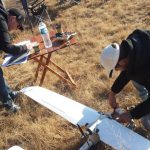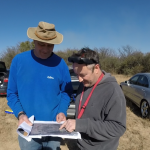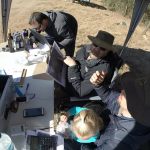1stFPV Rally in the world that improves Drone safety
by skullkey

30 July 2016 marks the 1st FPV (First Person View) Fixed wing RC (Radio Controlled) Rally in the world!
Henrico Hanekom, an entrepreneur and technology enthusiast, gathered his RC model flying friends who fly FPV recreationally on weekends to take up the unique challenge.
Pilot and Navigator teams braved the winter morning at a field outside the city (Pretoria-East, South-Africa) with great enthusiasm even though they were not quite sure what to expect. Each team had a pencil, calculator, protractor, video headset and radio controlled aircraft handy.
 |
 |
Left – Pilots and navigators being briefed, Right – Studying clue sheet
The tech
It was only until recently that various technologies like high-power low-weight Li-Po batteries, efficient Brushless motors, long range Video and control systems, open-source Autopilot software and hardware, MEMS (micro-electro-mechanical-systemslike the sensors in your smart phone) and others collided to fuse the exhilarating hobby called FPV flying.
Drones
Most people call multi-rotor aircraft “drones”…but few understand that fixed wing aircraft fitted with an auto-pilot system may also be classified as “drones”. There are many races being held for multi-rotors (especially mini quads) where speed and skills are tested, but never before has there been a Rally for FPV fixed wing pilots. Most operators build and customise their own aircraft from components available at hobby shops…typically with wing spans between 1 and 2 meters.
 |
 |
Left – Skywalker RC aeroplane approaching landing, Right – Home built pusher propeller RC aeroplane
Why a Rally?
The objective of such a Rally is to increase piloting skills, navigation skills and observational skills. It improves the operator’s ability to fly safer and more controlled whilst being aware of their geographical area, weather conditions and understanding the limitations of their aircraft. The Rally is conducted in non-auto pilot flight modes so even though autopilot features are present in the aircraft, it only kicks in when needed as a safety feature.
 |
 |
Left – Pilot and navigator getting ready to fly, Right – Pilot and navigator rehearsing the flight plan
How does it work?
Each team receives a clue sheet and a map with minimal data. From clues like leg distances, landmarks and direction the navigator has to plot the route and ETA’s (Estimated Time of Arrival) on their map within a certain time frame before they take off to execute the flight plan.
Penalties are incurred when a team misses a check point, make time errors, calculation errors, navigational errors, map observation errors and based on how far they land their aircraft from a line called a spot landing marker.
Contestants walked away with valuable flight experience and important lessons learned.
 |
 |
Left – Navigator discussing route with pilot, Right – Pilot flying with FPV (First Person View video headset)
Going forward
Henrico Hanekom believes that FPV Rallies can advance the safety and skills of those who fly “drones” recreationally and even commercially in a fun and non-hazardous environment.He hopes to see it become an internationally recognised flying discipline.
Video:

30 July 2016 marks the 1st FPV (First Person View) Fixed wing RC (Radio Controlled) Rally in the world! Henrico Hanekom, an entrepreneur and technology enthusiast, gathered his RC model flying friends who fly FPV recreationally on weekends to take up the unique challenge. Pilot and Navigator teams braved the winter morning at a field…
Get involved
Visit us on a Tuesday:
- Join us at 4 Burger Ave, Lyttleton Manor, Centurion every Tuesday evening from 18.00 till late (bring a project to work on or beer)
Telegram Group:
- Send a message to Schalk on Telegram to add you to the group - currently >100 users, relevant conversations for makers
IRL:
- Schalk 082 777 7098
After hours only, please rather send telegram message - Toby
http://tobykurien.com
- Not active at the moment, if you are interested in presenting a course, please let Schalk know
